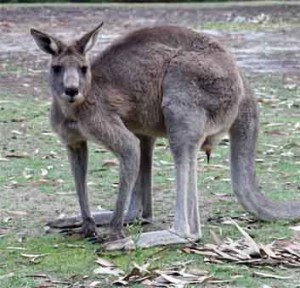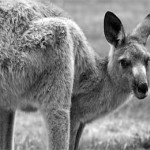Kangaroo harvesting in Australia – quotas & species
 Many people outside of Australia have an image of the kangaroo, emu and koala as soft cuddly toys. That they are national icons and presented on our money and coat of arms establishes these native animals as part of Australia folk lore. Originally they were hunted by aboriginals and formed a staple part of their diets, however this leads us to the current state of how kangaroos are harvested.
Many people outside of Australia have an image of the kangaroo, emu and koala as soft cuddly toys. That they are national icons and presented on our money and coat of arms establishes these native animals as part of Australia folk lore. Originally they were hunted by aboriginals and formed a staple part of their diets, however this leads us to the current state of how kangaroos are harvested.
Kangaroos present a moderately unique proposition on game meats. They are an animal that is native to Australia and have one of the healthiest protein and fat profiles of any meat source in the world. they tend to graze on clean undisturbed lands and so they are organic in nature too.
As discussed in the article on kangaroos and the environment ” kangaroo populations have increased dramatically since European settlement in these areas due to the introduction of European farming methods and, for this reason, carefully controlled harvesting is required.” Ref 1
How is Kangaroo harvesting/ culling done in Australia
“Kangaroo harvesting is carried out under the strict environmental controls provided by the Australian Government’s Environment Protection and Biodiversity Conservation Act 1999. The commercial harvesting of widespread and abundant kangaroo species contributes to the sustainability of the Australian environment.”
“The four species of kangaroo that are commercially harvested have very large populations. None is threatened or endangered. The Red kangaroo, Eastern grey kangaroo and Western grey kangaroo are the most abundant species and make up over 90 per cent of the commercial harvest. Their combined population size has fluctuated between 15 and 50 million animals over the past 25 years in the harvested areas, depending on seasonal conditions.” ref 1
“The harvesting of kangaroos is permitted on a quota basis that is reviewed annually and independent of market demand. Quotas are set on the basis of population size and trends, and long-term climate predictions. Conservation of the species remains the foremost consideration. This approach ensures that the harvesting of kangaroos is managed in an ecologically sustainable way.”
Kangaroos are only culled in the wild
There is no farming of kangaroos in Australia. Kangaroos are harvested in the wild by licensed hunters. The live export of kangaroos is prohibited under the Environment Protection and Biodiversity Conservation Act. There are a few exceptions where the purpose is non-commercial, such as inter-zoo exchanges.”
This is an important point that many people buying kangaroo meat want to know. Since kangaroos travel such large distances in the wild and have such great athleticism, any farming practice would be non humane.
How Kangaroos are caught
“Where kangaroos are taken for commercial use, they must be killed by a licensed, fully trained hunter. An Australian Senate Select Committee on animal welfare, after an extensive investigation, concluded that: ‘There is no doubt that the shooting of kangaroos by professional shooters is the most humane way of killing kangaroos’. Animal welfare considerations are a priority of the Environment Protection and Biodiversity Conservation Act. Kangaroo harvesting and processing is subject to strict regulations and all hunters face penalties if they do not abide by the National Code of Practice for the Humane Killing of Kangaroos. Compliance with the Code is a licence condition for commercial shooters in all states.” Ref 1
This is probably the most contentious point in the whole process of catching kangaroos.
Because kangaroos cover such large areas and can move so fast the only way to not harm other animals in the culling process has been found to be shooting.
The macropod species and which ones are culled
There are over 60 species of macropods (kangaroos, wallabies etc) in Australia.
These are their classes and number in each sub group: Kangaroo 11, Tree Kangaroo 2, Wallabies 10, Rock Wallabies 20, Nailtail wallabies 2, Pademelons 5, Quokka 1, Hare-wallabies 6, Bettongs 5, Potoroos 4 and Rat Kangaroos 1
Of the total macropod species it is only the largest ones that are in over population that are culled. There are only six sub species out of all the macropods that are culled and ONLY THREE out of these make up the majority of culls: “The Red kangaroo, Eastern grey kangaroo and Western grey kangaroo are the most abundant species and make up over 90 per cent of the commercial harvest”. Ref 2
The subspecies used in the quota system, and for export are shown in bold in the table below:
|
Species | Subspecies | Scientific name | State | |
| 1 | Red Kangaroo | none | Macropus rufus | QLD, NSW, VIC, SA, NT, WA | |
|
Eastern Grey Kangaroo | Mainland | Macropus giganteus giganteus | QLD, NSW, ACT, VIC | |
| 3 | Macropus giganteus tasmaniensis | TAS | |||
| 4 | Western Grey Kangaroo | Mainland | Macropus fuliginosus melanops | QLD, NSW, VIC, SA, WA | |
| 5 | Kangaroo Island | Macropus fuliginosus fuliginosus | SA | ||
| 6 | Common Wallaroo | Eastern Wallaroo | Macropus robustus robustus | QLD, NSW, ACT, VIC | |
| 7 | Euro | Macropus robustus erubescens | QLD, NSW, SA, NT, WA | ||
| 8 | Northern Wallaroo | Macropus robustus woodwardii | NT | ||
| 9 | Barrow Island Wallaroo | Macropus robustus isabellinus | WA | ||
| 10 | Antilopine Wallaroo | none | Macropus antilopinus | QLD, NT, WA | |
| 11 | Black Wallaroo | none | Macropus bernadus | NT | |
| 12 | Bennett’s Tree-kangaroo | none | Dendrolagus bennettianus | QLD | |
| 13 | Lumholtz’s Tree-kangaroo | none | Dendrolagus lumholtzi | QLD | |
| 14 | Agile Wallaby | none | Macropus agilis | QLD, NT, WA | |
| 15 | Black-striped Wallaby | none | Macropus dorsalis | QLD, NSW | |
| 16 | Tammar Wallaby | Kangaroo Island | Macropus eugenii decres | SA | |
| 17 | Mainland | Macropus eugenii derbianus | WA | ||
| 18 | Kwoora (Western Brush Wallaby) | none | Macropus irma | WA | |
| 19 | Parma Wallaby | none | Macropus parma | NSW | |
| 20 | Whiptail Wallaby | none | Macropus parryi | QLD, NSW | |
| 21 | Red-necked Wallaby | Mainland | Macropus rufogriseus banksianus | QLD, NSW, ACT, VIC | |
| 22 | Bennett’s Wallaby | Macropus rufogriseus rufogriseus | TAS | ||
| 23 | Swamp Wallaby | none | Wallabia bicolor | QLD, NSW, ACT, VIC, SA | |
| 24 | Allied Rock-wallaby | none | Petrogale assimilis | QLD | |
| 25 | Short-eared Rock-wallaby | none | Petrogale brachyotis | NT, WA | |
| 26 | Monjon | none | Petrogale burbidgei | WA | |
| 27 | Cape York Rock-wallaby | none | Petrogale coenensis | QLD | |
| 28 | Narbelek | Northern Territory | Petrogale concinna concinna | NT | |
| 29 | Kimberley | Petrogale concinna monastria | WA | ||
| 30 | Godman’s Rock-wallaby | none | Petrogale godmani | QLD | |
| 31 | Herbert’s Rock-wallaby | none | Petrogale herberti | QLD | |
| 32 | Unadorned Rock-Wallaby | none | Petrogale inornata | QLD | |
| 33 | Black-footed Rock-wallaby | Recherche Archipelago | Petrogale lateralis hacketti | WA | |
| 34 | Mainland | Petrogale lateralis lateralis | WA, NT | ||
| 35 | Pearson Island | Petrogale lateralis pearsoni | SA | ||
| 36 | Mareeba Rock-wallaby | none | Petrogale mareeba | QLD | |
| 37 | Brush-tailed Rock-wallaby | none | Petrogale penicillata | QLD, NSW, ACT, VIC | |
| 38 | Proserpine Rock-wallaby | none | Petrogale persephone | QLD | |
| 39 | Purple-necked Rock-wallaby | none | Petrogale purpureicollis | QLD | |
| 40 | Rothchild’s Rock-wallaby | none | Petrogale rothschildi | WA | |
| 41 | Sharman’s Rock-wallaby | none | Petrogale sharmani | QLD | |
| 42 | Yellow-footed Rock-wallaby | Queensland | Petrogale xanthopus celeris | QLD | |
| 43 | South Australia & New South Wales | Petrogale xanthopus xanthopus | NSW, SA | ||
| 44 | Bridled Nailtail Wallaby | none | Onychogalea fraenata | QLD | |
| 45 | Northern Nailtail Wallaby | none | Onychogalea unguifera | QLD, NT, WA | |
| 46 | Tasmanian Pademelon | none | Thylogale billardierii | TAS | |
| 47 | Red-legged Pademelon | Cape York | Thylogale stigmatica coxenii | QLD | |
| 48 | North Queensland | Thylogale stigmatica stigmatica | QLD | ||
| 49 | South Queensland & New South Wales | Thylogale stigmatica wilcoxi | QLD, NSW | ||
| 50 | Red-necked Pademelon | none | Thylogale thetis | QLD, NSW | |
| 51 | Quokka | none | Setonix brachyurus | WA | |
| 52 | Spectacled Hare-wallaby | Barrow Island | Lagochestes conspicillatus conspicillatus | WA | |
| 53 | Mainland | Lagochestes conspicillatus leichardti | QLD, NT, WA | ||
| 54 | Mala (Rufous Hare-wallaby) | Mainland | Lagochestes hirsutis hirsutis | NT | |
| 55 | Bernier Island | Lagochestes hirsutis bernieri | WA | ||
| 56 | Dorré Island | Lagochestes hirsutis dorreae | WA | ||
| 57 | Banded Hare-wallaby | none | Lagostrophus fasciatus | WA | |
| 58 | Rufous Bettong | none | Aepyprymnus rufescens | QLD, NSW | |
| 59 | Tasmanian Bettong | none extant | Bettongia gaimardi cuniculus | TAS | |
| 60 | Boodie (Burrowing Bettong) | none | Bettongia lesueur | WA | |
| 61 | Woylie (Brush-tailed Bettong) | none extant | Bettongia penicillata ogilbyi | WA | |
| 62 | Northern Bettong | none | Bettongia tropica | QLD | |
| 63 | Gilbert’s Potoroo | none | Potorous gilbertii | WA | |
| 64 | Long-footed Potoroo | none | Potorous longipes | VIC | |
| 65 | Long-nosed Potoroo | Tasmanian | Potorous tridactylis apicalis | TAS | |
| 66 | Mainland | Potorous tridactylis tridactylis | NSW, VIC | ||
| 67 | Musky Rat-kangaroo | none | Hypsiprymnodon moschatus |
References
Ref 1 http://www.dfat.gov.au/facts/kangaroos.html
Ref 2 http://www.rootourism.com/fact.htm


